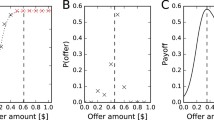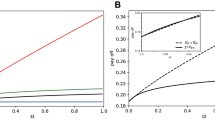Abstract
Empirical research has discovered that experimental subjects in ultimatum bargaining situations generally fail to play the decision-theoretic optimum strategy, and instead play something between that strategy and a fair split. In evolutionary dynamics, fair division and nearly fair division strategies often go to fixation and weakly dominated strategies can do quite well. Computer simulations were done using three different ultimatum bargaining games as determinates of fitness. (1) No tendency toward the elimination of weakly dominated strategies was observed, with or without mutation. (2) Strategies making fair demands had sizable basins of attraction. (3) In a system where five different demands can be made, demands closest to (approximately) 91% had the largest basins of attraction. (4) If the strategies have thresholds for acceptable demands, rather than individuated responses to each demand, the apparent optimum demand may be quite low: 64% for one set of trials.
Similar content being viewed by others
REFERENCES
Axelrod, R. and Hamilton, William D.: 1981, ‘The Evolution of Cooperation’, Science 211, 1390–6.
Barkow, Jerome H., Cosmides, Leda and Tooby, John: 1992, The Adapted Mind: Evolutionary Psychology and the Generation of Culture, Oxford University Press, New York.
Binmore, Kenneth G., Gale, John and Samuelson, Larry: 1993, ‘Learning to be Imperfect: the ultimatum game’, Working paper 9325 Social Systems Research Institute, University of Wisconsin.
Boylan, Richard T.: 1994, ‘Evolutionary Equilibria Resistant to Mutation’, Games and Economic Behavior 7, 10–34.
Güth, W., Schmittberger, R. and Schwarze, B.:1982, ‘An Experimental Analysis of Ultimatum Bargaining’, Journal of Economic Behavior and Organization 3, 367–388.
Hofbauer, Josef and Sigmund, Karl: 1988, The Theory of Evolution and Dynamical Systems, Cambridge University Press.
Maynard Smith, John and Price, George R.: 1973, ‘The Logic of Animal Conflicts’, Nature 246, 15–16.
Roth, A., Prasnikar, V., Okuno-Fujiwara, M. and Zamir, S.: 1991, ‘Bargaining and Market Behavior in Jerusalem, Ljubljana, Pittsburgh, and Tokyo: An Experimental Study’, American Economic Review 81, 1068–1095.
Schuster, Peter, and Sigmund, Karl: 1983, “Replicator Dynamics”, Journal of Theoretical Biology 100, 533–8.
Skyrms, B.: 1994, ‘Evolution of an Anomoly’, Technical Report MBS 94–22, Institute for Mathematical Behavioral Sciences, University of California, Irvine.
Thaler, R., 1988, ‘Anomolies: The Ultimatum Game’, Journal of Economic Perspectives 2, 195–206.
van Damme, Eric: 1991, Stability and Perfection of Nash Equilibria, 2nd. Edition, Springer-Verlag.
Author information
Authors and Affiliations
Rights and permissions
About this article
Cite this article
Harms, W. EVOLUTION AND ULTIMATUM BARGAINING. Theory and Decision 42, 147–175 (1997). https://doi.org/10.1023/A:1004919326873
Issue Date:
DOI: https://doi.org/10.1023/A:1004919326873




